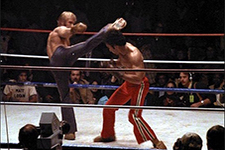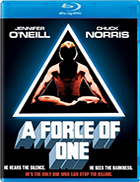A Force of One
|  When he turned to acting in the mid-1970s, Chuck Norris, a former middleweight world karate champion, tried to avoid playing conventional martial-arts heroes. In his first two leading roles, as a trucker in Breaker! Breaker! (1977) and as a special ops commando in Good Guys Wear Black (1978), his prowess with roundhouses and flying fisticuffs was minimized in favor of plots focusing on familial drama and government conspiracy theories, respectively. Of course, as a well-known karate champion, he was still expected to deliver a few blows here and there, but they weren’t the focus, as Norris was keen to distance himself from the films of Bruce Lee, against whom he had sparred on screen in The Way of the Dragon (Meng long guo jiang, 1972). A Force of One changed all that, as Norris plays Matt Logan—a “karate man” as he is repeatedly called in the film’s awkward, dated parlance—who is recruited by his city’s police department to train their officers in martial arts to help them break up a drug-smuggling operation. I know, I know—it is a strained plot device designed to foreground Norris’s martial-arts know-how, and it doesn’t really work at all. In fact, not much of anything works well in A Force of One, including the title, which makes absolutely no sense given that Norris’s character is working with the police and, truth be told, isn’t even driving the narrative. His character is prominent, but Norris actually takes second billing to Jennifer O’Neill’s Mandy Rust, one of the police detectives working the case. O’Neill—who is barely recognizable with her short-cropped hair, which she did to win a role in Disney’s The Black Hole (1979), which she subsequently lost—was arguably the bigger star at the time, having been established by her roles in Robert Mulligan’s poignant coming-of-age drama Summer of ’42 (1971) and Luchino Visconti’s final film The Innocent (L’Innocente, 1976). O’Neill’s character works alongside several other detectives, including Rollins (Superfly’s Ron O’Neal), for Captain Dunne (veteran character actor Clu Gulager), who is determined to snuff out the growing drug-smuggling operation at the heart of their small California town. The script was originally penned by Ernest Tidyman, who had won an Oscar for writing The French Connection (1971), before being significantly rewritten by director Paul Aaron in a bid to align it more with Norris’s rising star. There is a clear attempt to humanize Norris’s character by making him an empathetic father figure, having adopted an orphan named Charlie (Eric Laneuville) who is now a teenager and is training to follow in his adoptive father’s footsteps. Great effort is made to depict Matt as a caring karate instructor, as we see him early on teaching and sparring with children. At the same time, the film doesn’t want us to forget Norris’s martial-arts bad-assery, so we get a lengthy sequence that depicts him in the ring defending his title, and the film’s climax also involves him in the ring, this time fighting against Sparks (Bill “Superfoot” Wallace), a competitor hired by the drug smugglers as an enforcer and assassin. For fans of the sport, seeing Norris and Wallace, the latter of whom was then the undefeated Professional Karate Association middleweight world full-contact karate champion, sparring on-screen must have been exhilarating. Unfortunately, it is mired in a film that is mostly a slog, redeemed here and there by the genuine chemistry between O’Neill and Norris and the karate action. Most of the drama is inert, and the stabs at humor mostly fall flat. Director Paul Aaron, who took over the reins from original director Ted Post (Good Guys Wear Black), is at his best when he simply allows Norris to command the screen, which he does well enough (he had clearly improved as an actor since his initial forays on the big screen in supporting roles). Aaron recognized that Norris was playing a variation on the reluctant Western hero, and the film builds steadily to the eventual break when his character has to resort to violence in order to achieve justice. Aaron, however, piles on the dramatic slow motion to such an extensive degree that some action sequences that should be thrilling start to feel a bit ludicrous. Sometimes, too much is simply too much.
Copyright © 2022 James Kendrick Thoughts? E-mail James Kendrick All images copyright © Kino Lorber | |||||||||||||||||||||||||||||
Overall Rating: 
 (2)
(2)


